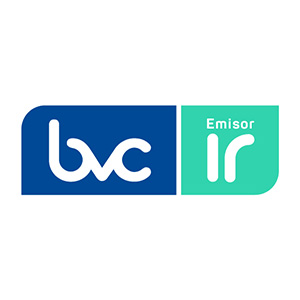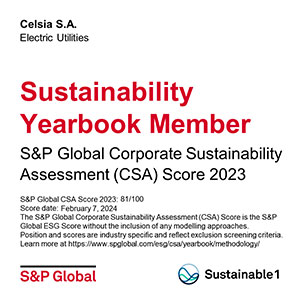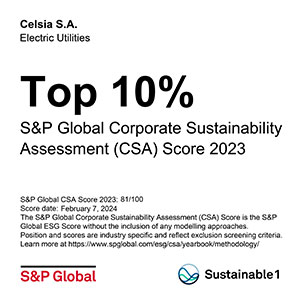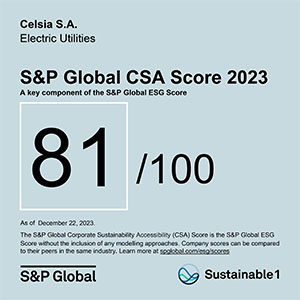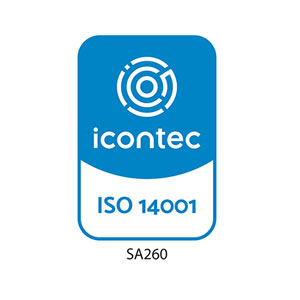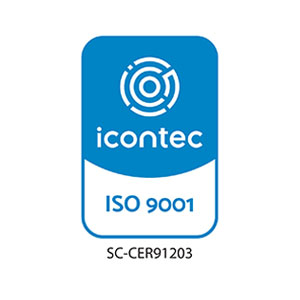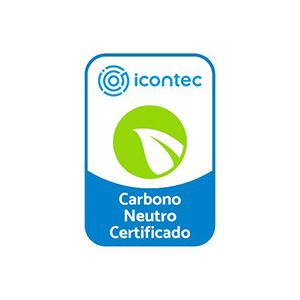Eco-efficiency and the circular economy are fundamental to addressing current environmental challenges. We seek to maximize production with minimal environmental impact and the sustainable use of resources by closing product life cycles. We work to build a sustainable future and mitigate pressure on ecosystems, promoting efficiency in the use of resources and reducing waste.
GRI (3-3) Eco-efficiency allows us to optimally use natural resources, contributing to their conservation. Aligned with socio-environmental goals, we apply principles of good socio-environmental practices in our assets and projects, such as efficiently using energy, comprehensively managing waste or trash, managing water resources and discharges, and controlling atmospheric emissions. These practices allow us to grow sustainably, taking into account the expectations of our stakeholders.
Our Management
GRI (3-3) We are passionate about innovation. Therefore, our management focuses on savings, and the efficient use and conservation of natural resources. This allows us to build a sustainable future for everyone. Our projects and assets in operation are governed by good socio-environmental practices framed by the Environmental Policy. We comply with the highest national and international standards seeking continuous improvement.
Our environmental management encompasses and impacts the entire business portfolio. We establish a framework for action and efficiently manage natural resources by implementing the Environmental Management System, taking into account our stakeholders and leveraging our future operations through actions aligned with the organization’s socio-environmental goals and compliance with current environmental regulations. Our management focuses on:
- Updating environmental goals and establishing indicators for different businesses.
- Managing information on environmental variables in the operation and maintenance of assets to strengthen the reporting, registration and consolidation of information for decision-making.
- Improving the optimization of natural resources.
- Avoiding environmental contingencies.
- Mitigating atmospheric emissions from stationary and mobile sources.
- Improving the stability of soils and preventing their degradation.
- Promoting the sustainable use of water and biodiversity.
- Implementing actions aimed at the circular economy for the optimization of renewable and non-renewable resources.
- Sustainably managing natural resources and biodiversity under the principle of the mitigation hierarchy throughout the life cycle of projects and assets in operation.
Waste Management
We implement appropriate practices in waste management, ensuring compliance with laws and improving our environmental performance.
We are committed to comprehensive waste management with the aim of reducing waste in operations. To this end, we adopt circular economy principles through a procedure that prevents impacts on human health and pollution. We achieve this by applying guidelines and responsibilities that the teams of the different businesses and their contractors must follow, in accordance with the established environmental policy.
Responsible waste management is an essential element in our commitment to sustainability.
With this purpose, we have established the goal of achieving effective management of 90% of our waste by 2025. We mainly focus on the preventing, reducing, reusing and recycling waste through various strategies:
Prevention
- Eco-efficient design: We implement it in our projects to minimize the generation of waste from the beginning.
- Sustainable purchasing: We prioritize purchasing products with less waste generation and packaging.
- Responsible consumption: We promote it among our employees, customer and other stakeholders.
Reduction
- Separation at the source: We implement programs to facilitate recycling and reusing materials from the source.
- Digitization: We digitize documents and processes to reduce paper consumption.
Reuse
- Donation: We donate materials in good condition to entities that need them.
- Internal reuse: We reuse materials in our operations wherever possible.
Recycling
- Internal recycling: We internally recycle materials, such as paper, cardboard, plastic, glass, and others.
- Strategic partnerships: We work with authorized managers to ensure the correct treatment of waste.
Training
- Training employees: We train them in responsible waste management
- Community awareness: We raise awareness about the importance of recycling and reuse.
Infrastructure
- Temporary waste storage units: We have points in our work centers for correctly separating waste.
- Specific containers: We have these for different types of waste.
Technology
- Tracking systems: We use them to monitor waste management.
- Digital tools: We implement them to optimize waste management.
We are convinced that responsible waste management is essential to build a better future for everyone. Therefore, we assume a firm commitment to protecting the environment and promoting a circular economy.
Non-hazardous Waste
GRI (3-3)
- We continue implementing the forestry program that takes advantage of the plant material resulting from maintaining high, medium and low voltage lines in composting activities.
- We recovered 4,200 clean garments from our obsolete corporate supply inventory to contribute to the reduction of textile waste for the environment. Now, they will be presented as souvenirs and corporate gifts.
- We increased recyclable waste from the organization’s processes by 16%.
- We continued the internal and external reuse of waste generated during operation and maintenance. It increased compared to 2022.
Hazardous Waste
GRI (3-3)
- In 2023, we will reduce hazardous waste disposed of in safe landfills by 98% compared to the previous year.
- We are seeing an increase in the amount of hazardous waste that, due to its properties, may be susceptible to internal or external reuse. This waste is constantly generated, driven by the magnitude of maintenance, whether major or minor, that occurs in the different businesses.
Other Waste
SASB (IF-EU-140a.2) At Celsia, we do not have assets operating from solid hydrocarbon (coal). Therefore, we do not generate gypsum and ash waste in any of our operations.
Management of Other Emissions
We are aware of the difficulties of working in an environment that is constantly changing. Therefore, we assume the responsibility of managing the environmental impact caused by atmospheric emissions. We invest a significant number of resources in implementing cleaner fuels and efficient technologies that are not only environmentally friendly, but also contribute to adaptation to climate change.
Atmospheric emissions(particulate matter, sulfur dioxide, nitrogen dioxide and SF6)
GRI (3-3)
- We obtained a 14.5% reduction in SF6 emissions thanks to good practices and predictive and preventive maintenance carried out on assets in operation.
- For the reporting year, we met the established goal of PM, NOx and SOx set by the organization. We are also within the permitted limits in the countries in which we are present.
SASB IF-EU-120a.1 We do not have assets operating from solid hydrocarbon (coal). Therefore, we do not generate Mercury emissions in any of our operations. The PM, NOx, and SOx pollutants emitted are not in densely populated areas or close to them.
Management of Energy Resources
The proper management of energy resources, such as water and energy, is essential to guarantee environmental sustainability and the permanence of our business over time.
Water resources are the most important component of our ecosystem. It is a fundamental basis for the planet’s sustainable development and a primary resource for the power generation sector’s operation. Moreover, responsible energy management, focused on renewable sources and efficiency, contributes to reducing environmental impact and strengthening energy security.
These practices are key to building a sustainable and balanced future. We focus on developing non-conventional technologies that take advantage of the wind and solar potential of the territories, as well as the use of fuels with low emissions. These actions allow us to project a new horizon for the company, taking care of every detail and evaluating the possible impacts on water and other natural resources, as well as the risks associated with developing our operations.
Water Consumption
Every drop counts. We value every drop of water as if it were the last. Our efforts are focused on preserving this vital resource, ensuring its availability for future generations.
GRI (303-1) Water, in addition to being an essential natural resource for life in all its forms, is our fundamental input for the energy generation business. The company has 19 hydroelectric power plants in Colombia and Central America, which generate more than 67% of its energy. These plants are located in basins with demand for water for human consumption and water protection areas.
Hydroelectric generation does not consume water, but it does depend on its availability for sustainability. Therefore, we work to optimize its use in operations, conserve it in the hydrographic basins where we operate, and raise awareness among our employees, customers, communities and suppliers of the importance of responsible water management. In this way, we implement various programs that focus on:
Efficient water use in generation plants
- Water consumption measurement and control: We have water measurement and control systems in all generation plants, which allows us to identify opportunities for improving and optimizing its use.
- We implement and manage the Efficient Water Use and Savings Programs (PUEAA, for the Spanish original) approved by Colombian environmental authorities.
- Implementing efficient technologies: We invest in implementing technologies that allow more efficient water use in processes, such as recirculation systems, wastewater treatment and the use of rainwater.
- Training for employees: We work with employees on the importance of efficient water use and best practices for management and responsible consumption.
Watershed protection
- ReverdeC Program: We implement watershed restoration and conservation initiatives through the ReverdeC foundation. We planted more than 15 million trees, playing a crucial role in regulating the water cycle and protecting water sources.
- Strategic partnerships: We establish partnerships with various local actors, such as communities, NGOs and government entities, to develop and implement projects aimed at protecting and conserving watersheds.
Environmental awareness and education
- Awareness campaigns: In order to highlight the relevance of the issue, we carry out awareness campaigns aimed at employees and communities, focusing on underlining the importance of water and the need to use it responsibly.
- Environmental education programs: We implement them in educational institutions and communities with the objective of fostering understanding and appreciation for water, promoting knowledge about its importance and preservation.
Research and innovation
- We participate in research and innovation projects to develop new technologies and innovative solutions that allow more efficient use of water in the energy sector.
By implementing these programs, we are able to:
- Reduce water consumption in generation plants.
- Protect and conserve watersheds in the areas in which we operate.
- Raise awareness among employees and communities about the importance of water.
GRI (3-3) In 2023, the main results in water consumption were:
- We formed a civil infrastructure operation and maintenance team in charge of carrying out periodic maintenance on the aqueducts and Domestic Wastewater Treatment Systems (STARD, for the Spanish original), allowing us to review correct hydroelectric operations, support the maintenance activities of the grease traps and the outsourced activity of sludge extraction, reporting its levels and supernatants in the structures.
- We have a contract with the company Dragon Colombia S.A.S. for removing and extracting sludge in the STARD, according to the accumulation of sludge and natans in the structures.
- We held three awareness days for employees and contractors focused on highlighting the importance of properly managing drains and the possible repercussions of incorrect use on Wastewater Treatment Systems (STARD).
- We implemented washing automation in the maintenance of solar panels, optimizing between 1.3 to 1.6 liters of water per solar panel and reducing the demand for water resources in the area in which we operate.
- We optimized rainwater use for domestic activities and panel washing.
- We continued with implementing water savings and efficient use plans approved by environmental authorities in Colombia.
Discharge Management
GRI (3-3) We have a Domestic Wastewater Treatment System (STARD) for our headquarters or work centers, which have a water concession for domestic use. It facilitates controlled discharges, meeting the requirements established by the current environmental regulations of each country in which we are present.
IF- EU-140a.2
During 2023 at Celsia we had no incidents of non-compliance associated with water quantity and/or quality permits, standards and regulations.
Water Risks
GRI (303-1) SASB: IF-EU-140a.3
Click on the tabs for additional details.
-
Quantity and Quality Risks
-
Conflict Risk
-
Regulatory Risk
Quantity and Quality Risks
GRI (303-1) SASB: IF-EU-140a.3 Our Environmental Policy seeks to foster partnerships to implement projects and actions that promote efficient water management and adequate discharge management. In addition, it establishes guidelines or managing water resources to guarantee continuous improvements within our system management and comply with legal regulations through innovative conservation practices and the efficient use of natural resources. We seek comprehensive management of environmental impacts and adequate diligence throughout the value chain, with the participation of our stakeholders. Our goal is to ensure the long-term sustainability of the organization.
Our programs to reduce water consumption and efficiently use water resources:
- Using rainwater in the organization’s administrative buildings and solar farms.
- Restoring and conserving watersheds.
- Installing high-precision flow measurement equipment to obtain water balances.
Scenario analyses
By developing and maintaining the hydrometeorological network, we evaluate the possible risks linked to operating the generation plants and their environment. This analysis covers scenarios, such as floods, droughts, landslides and other natural events. We use meteorological data to predict the flow and availability of water in reservoirs, planning the operation of hydroelectric plants in this way. In addition, we complement this information with modeling tools to estimate the impact of climate change on water availability and plant performance.
We include the review of the quality of the water resource in the reviews of potential impacts on operations, evaluating the quality of the water used for energy generation, the amount of sediments, nutrients, contaminants and other elements that may affect the characteristics of the resource.
Our strategies for estimating changes in local water availability include:
- Using the Water Atlas Risk tool to identify month-by-month variations in water availability in the areas where our facilities are located, allowing us to predict significant changes in the amount of water.
- Continuing the expansion and maintenance process of the meteorological network implemented since 2020, monitoring meteorological variables and expanding the observation of aspects related to the quality of the resource, such as measuring ecological flows and sediments in some plants.
Additionally, we use tools, such as Global Water Tools and the Water Risk Atlas, to identify water stress areas and monitor water availability in the basins in which our facilities are located. To monitor and track local water availability, we established consumption indicators to determine the demand of each site, design water resource reduction programs and formulate new strategies to promote the efficient and rational use of resources in our assets in operation.
Additionally, we use Siemens SCADA SPECTRUM software to measure water reservoir levels in real time, monitored at the Advanced Vision Operations Center (NOVA).
Conflict Risk
GRI (303-1) SASB: IF-EU-140a.3 We establish communication with stakeholders to carry out monitoring that not only focuses on possible conflicts, but also on identifying opportunities to support and promote their initiatives.
Participation can be observed by attendance at local water resource management boards in the areas of influence of projects under construction and assets in operation. Additionally, we implement watershed protection actions through participatory ecological restoration approaches, which involve local communities, institutions and community-based organizations in planning and executing these activities.
Furthermore, we carry out prior consultation processes with ethnic communities and maintain continuous information and communication activities with the various stakeholders in the territory.
We carry out the ReverdeC program’s interventions in coordination and with the approval of regional environmental authorities, prioritizing sites with the greatest needs for improvement in forest cover and maximizing the positive impact on water and the beneficiary communities.
With respect to monitoring conflicts associated with water use, we use various mechanisms:
- Environmental impact assessments identify potential risks related to water resources, establishing environmental management plans to mitigate them.
- Prior consultations to evaluate impacts and agree on environmental management measures for specific projects or plants, identifying possible conflicts with stakeholders.
- Inter-institutional worktables that coordinate social actors in a watershed, in which we participate and identify possible conflicts over the use of water and establish prevention and response actions.
Based on the results obtained from the Global Water Tool and Water Atlas Risk, it was determined that:
- None of our operations are located in water-scarce areas.
- Our projects for 2025 and 2050 will not generate conflicts over water use.
- There is an abundance of water in both scenarios.
However, with the full implementation of the hydroclimatic monitoring network, we will be able to carry out continuous analyses of the variables to make sure we predict the behavior in the basins, anticipating periods of scarcity that may cause potential conflicts over the use of water by stakeholders.
Regulatory Risk
Energy consumption
We take care of energy consumption to preserve our resources and build a sustainable future. Every action counts on the path to responsible energy efficiency.
Energy consumption is crucial for the organization’s functioning, which is why the scarcity of energy resources is considered a strategic risk. To mitigate it, we identify the aspects and impacts related to energy consumption in management, which are continuously monitored.
Additionally, we promote projects to optimize energy consumption, conserve water and generate it from non-conventional renewable sources. Using these sources reduces pressure on non-renewable natural resources, which is aligned with our policies and strategies.
Our operation is based on commitments and goals, as well as current legislation. In addition, we constructively engage with stakeholders and adequately manage the impacts of our operations on the environment.
The energy management system is based on the following pillars:
Energy Planning
- We carry out comprehensive energy planning that includes defining objectives, goals and strategies to efficiently use energy in all its operations.
- The team specialized in energy management develops and implements the energy plan.
Measurement and Monitoring
- We have a system for measuring and monitoring energy consumption in all facilities.
- We formulate key performance indicators (KPIs) to evaluate energy performance and take corrective measures, when necessary.
Continual improvement
- We implement a program to identify improvement opportunities and develop action plans to optimize energy consumption.
Innovation
- We are committed to innovation as a tool to improve the energy efficiency of operations.
- We participate in research and innovation projects to develop and implement new technologies that allow more efficient energy use.
Culture of Energy
- We promote a culture of energy among employees, for everyone to commit to efficiently using energy.
- We carry out awareness and training campaigns to promote individual responsibility in energy consumption.
Results
By implementing this energy management system, we obtained the following accomplishments:
- In non-conventional renewable energy, we have 18 solar farms in the Celsia generation matrix. Seven solar farms joined in 2023: Dulima, Yuma, Flandes, Buga 1, Palmira 1 and Las Victorias 1 and 2, in Colombia, contributing to clean power generation.
- We increased energy self-consumption by 41%, with reference to 2022. We optimized the resource of the energy basket in the countries in which we are present.
- We reduced energy consumption in operations.
- We saved costs on energy bills.
- We reduced greenhouse gas emissions.
- We improved our competitiveness.
Circular Economy
Our commitment to the circular economy is not just a strategy, it is a philosophy. We redesign, reuse and recycle, creating a sustainable life cycle for our products.
We seek to implement actions aimed at the circular economy to optimize renewable and non-renewable resources, promoting efficiency in the use of resources and contributing significantly to the preservation of the environment.
Some of the circular economy initiatives we led in 2023 were:
Textile Endowment Campaign
- We collected 1.4 tons of used clothing items to reincorporate them, transformed into other materials, into the supply chain.
- We recovered 4,200 clean garments from our obsolete supply inventory, to transform them, using them in a new production cycle and contributing to reducing textile waste for the environment. Now, they will be present in corporate souvenirs.
Second Life Batteries
We recondition electric mobility batteries that end their useful life to store solar energy or as an energy backup at our Palo Blanco substation.
Post-consumption Plan for Containers and Packaging: 30/30 ANDI Vision
We actively participate in this collective initiative, which consists of managing a post-consumption plan to take advantage of 30% of the packaging of our brand products by 2030.
Circularity Criteria in RFPs (Request for Proposal)
We include circularity guidelines in our calls to suppliers, asking them to detail how they actively participate in closing the life cycle of the product and its by-products from the design phase of the goods to their use or final disposal, following the circular economy principles.
These are the goals we have set for ourselves in the short-term regarding the circular economy:
By 2025, a sustainable sourcing policy will be designed and will begin to be implemented. It will include environmental criteria for evaluating suppliers and purchasing goods and services required in the organization’s different processes.
By 2025, a circular economy policy will be designed and begin to be implemented. It will include guidelines for developing the company’s products, projects and services.

Energy
By 2025
25% of our installed capacity will come from non-conventional renewable sources.
By 2030
100% of the electrical energy consumed by the organization will come from certified renewable sources.
By 2030
Achieve 100% smart meters installed for non-regulated customers.
Waste and Circularity
By 2025
Celsia will achieve efficient management of 90% of its waste.
By 2030
Celsia will achieve 100% reusable, compostable or recyclable packaging for its own brands.
By 2025
A circular economy policy containing guidelines for the development of the company’s products, projects and services will be designed and implemented.
By 2025
A sustainable sourcing policy that includes environmental criteria for the evaluation of suppliers and the purchase of goods and services required in the organization’s processes will be designed and implemented.
Topic / Indicator | Own indicators | CSA S&P Indicator | SASB indicator | GRI indicator | TCFD | External assurance |
|---|---|---|---|---|---|---|
Waste management – Non-hazardous | – | 2.3.2 | – | 306-3 | – | |
Waste management – Hazardous | – | 2.3.3 | – | 306-3 | – | |
Waste management – Other waste (Plaster and Ash) | – | 2.3.4 | (IF-EU-150a.1) | – | – | |
Managing other atmospheric emissions | – | 2.3.5, 2.3.6, 2.3.7, 2.3.8, 2.5.4 | (IF-EU-120a.1) | 2.4.2 | (Metrics and objectives – c) | |
Energy resource management – Water | – | 2.4.2 | (IF-EU-140a.1) | 303-3, 303-5 | (Metrics and objectives – c) | |
Energy resource management – Energy and fuel management | – | 2.2.1 | (IF-EU-000.E) | 302-1 | (Metrics and objectives – c) | |
Number of noncompliance incidents associated with water quantity and/or quality permits, standards and regulations. | – | 2.1.4 | (IF- EU-140a.2) | – | – | |
Water Risks – Description of water management risks and discussion of the strategies and practices to mitigate those risks | – | 2.3.4 | (IF-EU-140a.3.) | – | – |
Non-hazardous waste: Waste that does not cause damage to the environment or the health of living beings, since it does not undergo significant physical, chemical or biological transformations.
Hazardous waste: Non-recyclable waste that is considered dangerous due to its intrinsic properties that represent risks to health and the environment.
Waste disposed of for internal or external reuse: It refers to using waste again for the same original purpose or for a different purpose, avoiding its final disposal.
Safety landfill or waste: A facility designed to contain and isolate hazardous waste in a manner that minimizes the risk of harm to human health and the environment.
Atmospheric emissions: pollutants emitted directly into the atmosphere. Some originate as a consequence of chemical reactions and others correspond to the continuous or discontinuous discharge of matter, substances or forms of energy coming directly or indirectly from any source capable of producing atmospheric pollution.
CDM: Clean Development Mechanism.
VERRA: An international organization committed to supporting climate action and sustainable development through standards, tools and frameworks that evaluate the environmental and social impacts of projects and programs.

